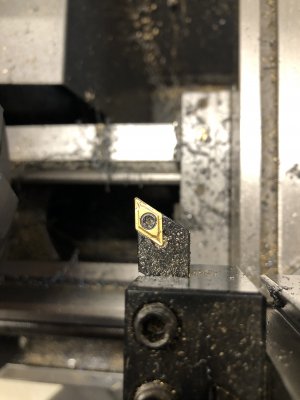Hi All
I am loving my new Jet BDB-919 lathe. Powerfeed is awesome. I notice one thing though that I would like to correct. When I initiate the powerfeed upon turning some rod stock I notice right at the point the bit meets the rod that the bit backs off (gets pushed back), just a bit. Maybe 1/1000. When using the scale on the crossfeed dial, this movement makes it so that my count down to my desired diameter is inaccurate. At most I take off 10/1000’s at a time whether it be brass or steel. The lathe has no issues with this depth of cut. I just want it to be accurate. Is the fix a tightening of the gibs on the crossfeed or on the top slide or tool post.
One last thing to note here. Given the above, you would think that if I set my depth of cuts at .010" and then bit slightly moves back, that the result would be a lesser depth cut, like .009". However, I just did three .010 cuts and I am .005" deeper into the stock than I should be. What is going on here?
I am loving my new Jet BDB-919 lathe. Powerfeed is awesome. I notice one thing though that I would like to correct. When I initiate the powerfeed upon turning some rod stock I notice right at the point the bit meets the rod that the bit backs off (gets pushed back), just a bit. Maybe 1/1000. When using the scale on the crossfeed dial, this movement makes it so that my count down to my desired diameter is inaccurate. At most I take off 10/1000’s at a time whether it be brass or steel. The lathe has no issues with this depth of cut. I just want it to be accurate. Is the fix a tightening of the gibs on the crossfeed or on the top slide or tool post.
One last thing to note here. Given the above, you would think that if I set my depth of cuts at .010" and then bit slightly moves back, that the result would be a lesser depth cut, like .009". However, I just did three .010 cuts and I am .005" deeper into the stock than I should be. What is going on here?


